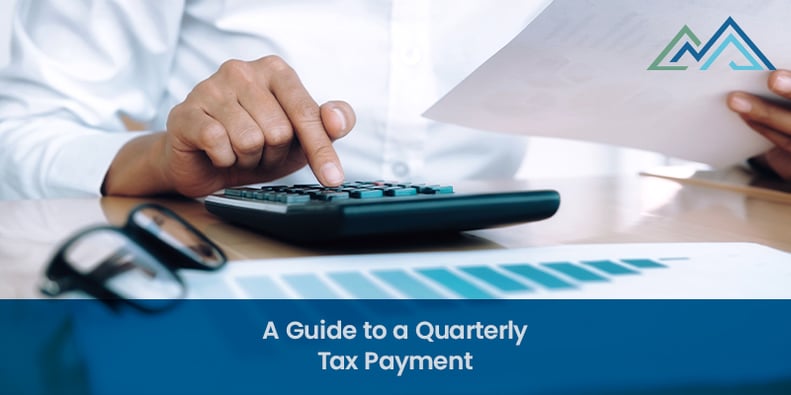Quarterly tax payments are required of some individuals and all businesses, and the rules around who needs to make them and how they differ from withholding taxes can be complex. Anyone who needs to make quarterly tax payments should be aware of the requirements and how to calculate and make payments on time.
At CMP, we have many clients who are required to pay taxes every quarter. In this post, we’ll explain who is required to make quarterly tax payments, how to calculate them and provide clarification of the rules.

What are Estimated Quarterly Tax Payments?
Earners in the United States pay taxes to the Internal Revenue Service in one of two ways. The first is through employer withholding.
Any employee getting paid by a company receives a paycheck where appropriate taxes, including income tax, Social Security tax, and Medicare tax, are withheld based on the employee’s tax election on their W-4 form.
The second way people pay taxes is by making estimated tax payments to the IRS on a quarterly basis. Estimated taxes are calculated based on earnings and must be paid by the end of each quarter. There is an option to pay taxes on a weekly or monthly basis if that is easier, provided that all estimated tax payments are made by the end of the quarter.
Estimated quarterly tax payments may include the following:
- Income tax
- Self-employment tax
We’ll get into detail about how to calculate your estimated quarterly tax payments in a later section.
Who is Required to Make Estimated Quarterly Tax Payments?
Several categories of earners may be required to make estimated quarterly tax payments:
- Small business owners. Owners of small businesses may be required to make quarterly tax payments based on their earnings and must do so if they expect to owe more than $500 in taxes
- Self-employed individuals. Self-employed individuals may be required to remit their estimated quarterly tax to the IRS based on their earnings, including the self-employment tax and the employer’s share of Medicare and Social Security taxes
- Certain high-income taxpayers. High-income taxpayers with income not subject to withholding must pay their estimated taxes quarterly
Even employees subject to withholding may be required to pay quarterly taxes if they have income from other sources. Examples include rental income, interest, dividends, royalties, and capital gains.
You will also be required to make quarterly tax payments if your total tax withholding and any refundable credits will not cover the smaller of 90% of your tax liability for the current year or 100% of your liability for the previous year.
There’s a higher threshold of 110% of your previous year's liability if you have an adjusted gross income over $75,000 if you are single or married but filing separately. However, if married and filing jointly, it becomes $150,000 or greater.
Exceptions to the Requirements for Estimated Tax Payments
There are a few exceptions where taxpayers may not need to make estimated quarterly tax payments.
Zero Tax Liability
If you are a US citizen or resident for the whole tax year and have zero tax liability for the previous year, you do not need to pay estimated quarterly taxes. Your previous tax year must be 12 months to qualify for this exception.
Farmers and Fishermen
Farmers and fishermen are not required to make quarterly tax payments throughout the year. For those who operate on a calendar year, the only due date for taxes is the 15th of January. Alternatively, if a farmer files their tax return and pays the tax due by March 1st, no estimated tax payments are required.
Farmers and Fishermen operating on a fiscal year have the same two options. The first is to pay the estimated tax by the 15th day of the first month after your tax year has ended. The second option is to file your return and pay your taxes by the first day of the third month after the end of your tax year.
Certain Corporations
There is also a quarterly tax exemption for small businesses and corporations if they expect to owe less than $500 in taxes. In that case, they may pay taxes annually.
How to Calculate Quarterly Tax Payments
Calculating your quarterly taxes isn’t complicated. However, there is more than one way to do it. The first is to use IRS Form 1040-ES if you’re an individual required to pay quarterly taxes. Your actual quarterly income, or the total taxes you paid for the previous year, can be used as a benchmark.
For business owners, the calculation will depend on the business structure. Sole proprietors, or anyone that operates through an LLC, would need to pay both income and self-employment taxes.
Business taxes may be calculated on either a quarterly or an annual basis. As a rule, you want to use the Annual basis if your income remains steady every month and a quarterly calculation if your income fluctuates.
There is also an option for you to take the previous year’s annual tax and split it into 12 equal monthly payments.
The corporate tax rate as of 2022 is 21%, but there is also now an Alternative Minimum Tax (AMT) for corporations as part of the Inflation Reduction Act. That amount is 15% of a corporation’s adjusted financial statement income (AFSI) over the corporate AMT foreign tax credit.
As a corporation, you’ll also need to remit your payroll taxes on a quarterly basis. The easiest thing for most businesses is to calculate their estimated annual income tax, divide it by four, and do the same for your payroll taxes.
When Are Quarterly Tax Payments Due?
Quarterly tax payments must be remitted to the IRS at the end of each quarter. Here is a list of the date ranges and due dates for each quarter.
- First quarter- January 1 to March 31, payment due on April 15
- Second quarter- April 1 to May 31, payment due on June 15
- Third quarter- June 1 to August 31, payment due on September 15
- Fourth quarter- September 1 to December 31, payment due on January 15 of the following year
You’ll note that the quarters aren’t divided equally, with the second quarter having only two months and the fourth having four.
How to Make Quarterly Tax Payments
There are multiple options for making your quarterly tax payments if you are filing as an individual and only one if you are filing corporate taxes.
Individual Quarterly Tax Payments
Individual taxpayers can use Form 1040-ES’s instructions to calculate their estimated tax payments. Once the amount has been calculated, there are multiple ways to remit payment. They include:
- Mail a check to the Internal Revenue Service with Form 1040-ES.
- Use the IRS2Go app to pay your taxes from your mobile device.
- Pay your quarterly taxes online at IRS.gov.
- Call the IRS to make a payment.
- If you have an IRS account, you can go to IRS.gov/account and log in to view your payment history and make payments.
The IRS recommends using the Electronic Federal Tax Payment System (EFTPS) as the easiest way to pay taxes. As a reminder, you have the option to pay your taxes weekly or monthly if that’s easier for you, and you’ll be able to view your entire payment history via EFTPS.
Corporate Quarterly Tax Payments
Corporate quarterly taxes have stricter rules than individual taxes concerning how companies may pay their estimated taxes.
According to the IRS, corporations must use the Electronic Federal Tax Payment System to deposit their quarterly taxes.
If you need additional information about corporate estimated tax payments, refer to Publication 542, Corporations, or work with an experienced tax professional.
What Happens if You Miss a Quarterly Estimated Tax Payment?
As we have already noted, quarterly estimated tax payments must be paid by the due dates for each quarter. Ideally, every taxpayer would make their payments on time, but what happens if you miss a quarterly estimated tax payment?
The IRS has the right to charge a penalty if you are late, even if it’s only by a day or due for a refund when you file your annual tax return.
If you are late with your quarterly payment, here’s what you should do:
- Calculate the tax you owe using Form 1040-ES
- Calculate your penalties using Form 2210
- Add these two numbers together
- Pay the total due as soon as possible
One of the most common mistakes that people make when paying estimated quarterly taxes is thinking they can wait until the next quarterly due date to make up their payment.
The risk with that decision is significant because your late payment will continue to accrue penalties until you pay it.
The best line of action is to pay as quickly as possible after the deadline and include payment for estimated penalties. Then, we strongly recommend creating a system that allows you to set aside money for estimated taxes so you never miss a deadline again.
The “Safe Harbor” Provision for Estimated Tax Payment
The so-called “Safe Harbor” provision is something that may enable people and businesses required to pay estimated quarterly taxes to avoid penalties for underpaying their taxes.
It is most likely to be useful to people who have a steady monthly income, and it may require ongoing calculations to be safe. Here are the Safe Harbor requirements as of 2023.
- You must pay either 100% of your previous year’s taxes or 90% of your current year’s taxes at a minimum
- If you earn more than $150,000 (or $75,000 if married and filing separately), you must pay the lower of 110% of the previous year’s taxes or 90% of the tax shown on the current year’s return
If your income increases in the middle of the year—for example, if you were to sign a lucrative contract—then you should increase your quarterly payments to be safe.
Even if you don’t qualify for the Safe Harbor rule, you may still be able to avoid an underpayment penalty if you meet one of these qualifications.
- You didn’t pay due to a disaster, casualty, or another circumstance that would make it unfair to impose a penalty; or
- You retired (after age 62) or became disabled in the current or prior tax year and had a reasonable cause for not making the payment, and your underpayment was not due to willful neglect.
To avoid penalties, seasonal businesses can take their annual tax for the previous year and pay it in monthly installments, which could help them to smooth out their cash flow.
Let Us Help You Navigate the Complexities of Estimated Tax Payments
Making estimated quarterly tax payments may feel like a burden, but it’s one that self-employed individuals and business owners must bear. The information we have provided here will help you calculate your quarterly taxes accurately and pay them on time.
Do you need assistance navigating the complexities of estimated tax payments? CMP can help. We offer comprehensive income tax services that can assist you in handling all aspects of estimated tax payments. Contact us to schedule a free consultation today.

















